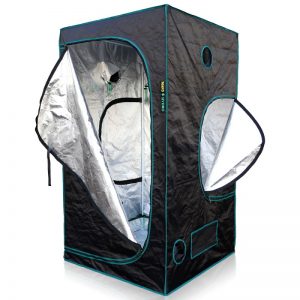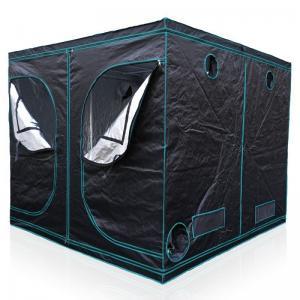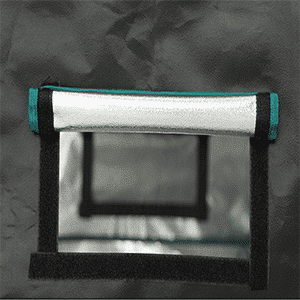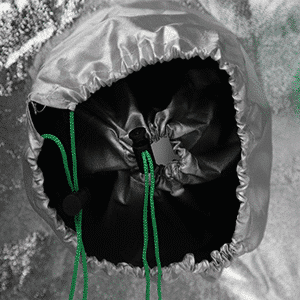What is a grow tent?
A grow tent is comprised of a lightweight, six-sided fabric exterior installed over a rigid frame and includes a main opening and various apertures suitable for electrical access, ventilation and other functions.


There are hundreds of grow tent varieties on the market offering a range of sizes and features for different applications and budgets.
Although there are complete grow tent packages that include the tent, onboard lighting and other components to make startup fast and easy right out of the box, grow tents are carefully designed to accommodate multiple hydroponic or even soil pot arrangements using a range of equipment.
The importance of quality grow tent material
Even though choosing the right size tent may be your first concern when considering a grow tent purchase, size isn’t the only important factor. The material used to construct the tent is often a basic determiner of overall quality.

Here’s how it works: A heavy-duty canvas outer fabric, often nylon or polyester, is bonded to a reflective inner layer, often made of biaxially-oriented polyethylene terephthalate. The outer fabric is strong and durable, while the inner fabric increases light efficiency by providing excellent reflectivity.
The thickness of a tent’s outer fabric shell is expressed using linear mass density, or denier, as a measurement.
That’s the D referenced next to the number, like 600D, in a tent’s fabric description. Denier refers to thread or yarn thickness, with one denier representing the base standard, the approximate thickness of a single strand of silk.
The higher the number, the stronger and denser the fabric will be. Grow tents are produced with exterior fabrics that can range anywhere from 200D to 1680D.
That’s a big span. Although opinions vary, many industry insiders recommend an exterior fabric between 600D and 900D as a strong and durable option. Large tents and tents that will be knocked down and reassembled often may require fabric at the high end of the range, or even a more durable, higher-denier fabric.
A tent’s inner liner is designed to help reflect light, and lining materials are rated based on the amount of light they reflect.

There’s a big range here as well, from 50 to more than 90% reflective capability. This feature carries with it a couple of big benefits. Efficient light reflection means less wasted energy, and energy cost savings over time.
It also means better light coverage for underlying foliage because light is being reflected from the sides as well as from the top of the tent where most primary light fixtures are located.
Purchasing a grow tent made of a higher quality fabric is a good investment in a number of ways. Since the fabric rests on a structure of supporting poles, after installation the roof seams sustain some of the tent’s weight.
Over time, this can stress seams and contribute to wear. Wear and tear can also take a toll on the seams and fabric around zippers. Stronger fabric also reduces the risk of punctures and abrasions, which can be a problem when using gardening tools in an enclosed environment like a tent.
A thicker fabric can contribute to a more lightproof enclosure, where a thinner fabric may permit minute gaps in the needle holes along seam lines to leak small amounts of light. If the hole is large enough for light to escape, there’s a chance micro-organisms can get in the same way.
Aside from thickness, other features to look for in grow tent fabric include mildew resistance, fireproofing and a statement that the material does not off-gas toxic vapors.
The use of some polyvinyl chloride (PVC) materials in tent construction, including their use as a reflective fabric material, has resulted in plant losses in the past and increased awareness of the problem across the industry.
When exposed to high heat, PVC can release toxic phthalates and other chemicals. Although a lot of manufacturers are focused on addressing the issue, there may still be products on the market with off-gassing problems, so it’s a good idea to look for a quality assurance statement regarding off-gassing on any grow tent you are considering or discuss the topic with a product representative.
The grow tent frame

The structure of a grow tent is made of a framework of supporting poles installed under the fabric shell. They provide stability and somewhat reinforce the shape of the exterior.
The frame does more than create a rigid, sturdy skeleton to hold up the fabric though. It also carries the weight of the mounted fixtures and other equipment inside the tent.
Tent frames can be made of a number of materials. Heavy-duty steel construction is strong and rigid but is also more expensive, heavier and may be more cumbersome to set up and break down than lighter-weight metal and synthetic materials that can still support heavy loads.
As a general rule, thicker poles with applicable fittings will sustain more weight than thinner poles and produce a more rigid, stable frame.
Manufacturers publish maximum weight ratings for their tent frames, and these are important numbers. Lightweight frames limit the type and amount of hanging equipment a tent can safely support.
In small tents, this may not be as significant because the size of the interior also limits the size of the equipment that can be installed inside.
In larger tents that have sufficient area to sustain numerous plants and sophisticated equipment, lights, ducts, fans, filters and other components can be heavy enough to overtax the maximum weight recommendations of some tents.
Grow tent zippers and seams

Two common complaints about grow tents are broken zippers and tears around zippers and seams. The door to a typical grow tent is sealed with a long, often multi-part zipper that maneuvers around curves and may be under tension from stretched fabric.
Most grow tents employ large-gauge, heavy-duty plastic zippers, but constant use still makes the zipper area a prime candidate for mishaps. Torn stitching and broken zipper teeth can happen in even high-quality tents, but may be avoided with proper care.
Keep zippers clean by brushing or wiping them regularly to remove dirt and grit that can become lodged in and around the teeth. If a tight zipper sticks, applying a thin coating of paraffin, talc or spray lubricant to the teeth may solve the problem without damaging the zipper.
Seam damage or tears around a zipper can be the result of pulling too hard, but may also result from regular wear when a low-denier fabric is used.
To avoid tearing of the zipper’s seams, some manufacturers double stitch their seams for added strength. It’s another feature that helps distinguish a quality tent.
Grow tent ports and vents
One of the goals of growing plants in an enclosed environment is regulatory control, so successfully managing access to the outside world is important.

This can be challenging since hydroponic, automation, ventilation and filtration equipment often need access to the environment outside the tent for electrical service, air circulation and other purposes.
A grow tent is usually designed to accommodate a variety of equipment from any number of manufacturers. Its onboard access ports, vents and other openings need to be strategically sized and located to suit as much equipment and as many set-up options as possible.
Those openings also need to be carefully crafted to help maintain the integrity of the environment inside the tent once the equipment is installed.
Speaking generally, larger tents offer more ports and vents because they use more equipment. That doesn’t tell the whole story though.
Some tents contain more of one type of port or vent than another, or the openings they do have offer added protection or functionality, like air and cord ports that have double flaps or vent cuffs with double-drawstring closures.

Understanding what you may need in a grow tent will help you avoid some potential pitfalls, such as choosing an undersized tent, one with small duct port openings, too few electrical cord ports, or a window on the side of the tent you plan to place against a wall.
These are specific considerations, and even though tents are designed to be flexible, these considerations can be sticking points when starting a new system or upgrading an existing one.
Because features vary from brand to brand and can differ based on size and model, understanding how you plan to use a grow tent, and knowing what equipment you may want to include, is a good first step in choosing the right sized and configured tent for your needs.
Final thoughts
The right tent set-up will make producing robust plants easier, more cost effective and more satisfying so it pays to research the many options available on the market today.
A good first stop is your local indoor gardening and hydroponics store.
